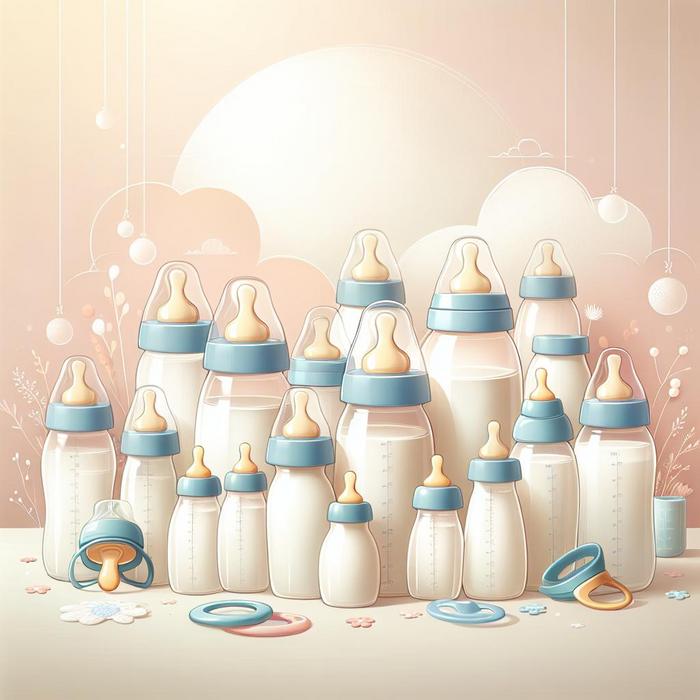The Significance of Right Feeding Bottles in Responsible Baby Care
Choosing the right feeding bottles is not just about convenience or cost, but also about laying the foundation for your baby’s healthy development. But with countless options available, how do you know what is the best for your newborn? Below are some key factors to consider.
Feeding Bottle Material
Feeding bottles predominantly come in three types of materials: plastic, glass, and silicone. While plastic bottles are lightweight and most common, concerns have been raised about BPA content in them (source). Glass bottles are BPA-free but are heavier and breakable. Silicone bottles are growing in popularity due to their damage resistance and BPA-free nature, as outlined by this article.
Nipple Size and Flow
Bottle nipples vary in size and flow rate to suit the baby’s age and feeding ability. Choosing the right nipple size is essential in preventing underfeeding or overfeeding (source). To make this process easier, check out these quick tips for effective feeding.
Here are some factors to consider when choosing the right feeding bottles:
- BPA-free material for safety
- Right nipple size for age and feeding ability
- Easy cleaning and assembly
- Shape and size for easy gripping
Best Baby Bottles as Recommended by Pediatric Dentists
Pediatric dentists recommend certain types of bottles due to their benefits for dental health. A good feeding bottle should encourage the proper sucking mechanism, which aids in developing the oral muscles and jaw. To understand more about this, refer to this informative post.
Exploring Advanced Feeding Solutions
While there are numerous bottle options, some feeding solutions are designed to mimic the natural feeding process. Biomimetic feeding solutions, for example, can offer a more natural feeding experience to your baby. Here’s an article illustrating why these bottles are worth considering.
Choosing the right feeding bottles is a critical part of responsible baby care. We hope these insights prove useful as you navigate the early stages of your parenthood journey.
Understanding Bottle Flow Rate
The flow rate of a bottle refers to how fast or slow the liquid comes out when the baby is sucking. This attribute primarily depends on the nipple’s design. The flow rate has to match the baby’s feeding capabilities to prevent choking or unwanted air swallowing. For an in-depth understanding of how to choose the appropriate bottle flow rate for your baby, visit this page.
How to Choose the Right Bottle
When choosing a feeding bottle, it’s not just about favoring a particular brand. Here are a few tips from Everyday Baby to ensure you pick the right bottle that suits your baby’s needs and contributes to their healthy growth:
- Pick an age-appropriate bottle: Most bottle brands categorize their products based on the baby’s age, which is tied to the bottle’s flow rate.
- Check the bottle and nipple quality: The bottle should be sturdy and the nipple should be soft yet durable, free of any cracks or tears.
- Easy to clean: Baby bottles should be easy to disassemble and clean to ensure maximum hygiene.
- Consider the bottle’s shape: The bottle should be easy to hold, for both you and your baby.
Importance of Sterilizing Baby Bottles
Proper sterilization of baby bottles is crucial to keep bacteria and viruses at bay, ensuring that your baby stays healthy. For a comprehensive guide on how to sterilize baby bottles, refer to this reliable source.
Switching from Bottle to Cup
As babies grow, they begin to transition from bottles to cups. This shift is necessary to enable the development of mature drinking skills, dental health, and independence. The CDC provides insightful tips on managing this transition effectively in this guide.
Final Thoughts
Although the process might seem overwhelming, it’s essential to remember that choosing the perfect feeding bottle is ultimately about your baby’s comfort and well-being. A well-chosen feeding bottle can make feeding times less stressful for both you and your baby while contributing substantially to their growth and development.
Taking time to research and understand each aspect ensures you provide your baby with a bottle that meets their unique needs, factoring in their age, feeding ability, and health, contributing positively to their overall wellbeing and growth.

